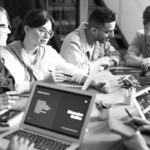Overview A Good Problem to Have When the CARFAX Delivery Team doubled in just four…
Case Study
Achieving Agile 2.0: The Cprime Dojo Experience
Company Details
Industry: Insurance
Company Size: 30,000 employees plus 13,500 independent brokers and agents
Location: New York, United States
Products: Personal and Commercial Casualty Insurance
Cprime Services:
Executive Summary
Consulting in partnership with senior leaders, the Cprime training team tailored and conducted a highly successful bespoke Dojo program focusing on advanced Agile methodologies to improve the company’s development cycle times, increase testing coverage and optimize the conversion of legacy code.

Highlights of Engagement
Consulting in partnership with senior leaders, the Cprime training team tailored and conducted a highly successful bespoke Dojo program focusing on advanced Agile methodologies to improve the company’s development cycle times, increase testing coverage and optimize the conversion of legacy code.
Overview
The company is a leading underwriter of commercial property-casualty insurance in the US and operates a large national personal insurance business through independent agents across the US. A Fortune 100 organization, they have an extensive international portfolio as well.
Through its network of nearly 50,000 employees, independent agents, and brokers, the company has established a solid reputation in the industry. Making the best of available technologies is how they remain at the top of their game and responsive to their clients’ needs.
The Challenge – Establishing Dojo Goals: The Wish List
In alignment with the company’s mandate for excellence in software development, a group of three executive sponsors sought to improve engineering practices. Their goal was clear: while they had already adopted Agile methodologies, they wanted to take their DevOps to a higher level, referred to internally as Agile 2.0.
Clarifying the mission, one sponsor explains the impetus to implement more current, modern practices. In particular, the company was shifting from a ‘write code now and test later’ ethos to the philosophy that code alone was not acceptable until a corresponding test mechanism accompanied it:
“Our teams were doing well writing code, but we wanted to mature them in writing tests, which was not that important three or four years ago. Now, however, for us, ‘code’ is the combination of both tests and code. Before, we’d throw the code over to the other side to be tested, but we wanted to change that. And to do that, we found that practices like test-driven development and pairing were key to achieving this maturity.”
Reducing the Development Cycle
In addition to maturing its processes, the company was looking to streamline its development cycle to match the accelerated timelines that are increasingly the norm in software development.
“We’re at the point now where instead of delivering things four times a year, we need to deliver much more quickly,” says one executive sponsor. “We used to have a lot more lead time. We wrote code, we tested, and two months later, we put it in production. Those days are gone. We need to test now at all levels.”
There was one final but significant pain point that the development team needed to address. It was common to most large enterprises with an established codebase: Breaking down legacy code to make it modern.
Keeping It Close to Home
The company needed more than simple classroom training. The team wanted a way to improve their practice, but they wanted it done onsite, in a non-disruptive manner that addressed their developers’ real-world work assignments and timelines.
As another executive sponsor put it, “We wanted someone to come to us and work with our teams on the things they had on their plates at the time. We couldn’t keep sending teams somewhere to be trained. We couldn’t scale that. We wanted to get the trainer in-house, on the floor.”
The Solution – Enter Cprime
The company knew it wanted a tailored, immersive, and experiential learning experience, but it wasn’t sure how to go about it on a larger scale. Finally, the team approached Cprime, trusted partners and experts in helping transforming businesses get in sync and redefine how work gets done through Agile, Product, and Technology. An executive sponsor admits:
“I fully expected Cprime to say, ‘We can’t help you because your situation isn’t perfect,’ but the team didn’t. They came back and said, ‘We can figure this out.’ And they did.”
The Place of the Way
Presented with the challenge of finding the best solution for the company’s unique requirements, Cprime responded with an on-site Dojo program. The Japanese term “dojo” literally means “the place of the way.” In DevOps terms, a Dojo is a physical and metaphorical safe space where teams can collaborate with embedded experts to learn Agile principles, improve software development processes, or embrace new frameworks and tools.
“We knew we wanted to adopt emerging best practices in software development, but we didn’t know how to go about it in a way that ticked all our boxes. Cprime took on our challenge and responded with, ‘This is how we can help you learn these practices with the scenarios you have.’”
– Executive Sponsor at the company
Dave Laribee, Head of Dojos and Strategic Advisor for Cprime, recalls the challenges the company brought to the table and summarizes the Cprime solution. “We aligned a couple of their COEs (Centers of Excellence) around engineering practices and set out working to improve their approach to test-driven development, acceptance test-driven development, and pair programming with an eye to gains in their team-level agility and their overall quality, productivity, and efficiency.”
As Laribee discovered, the group at the company was already well-versed in SAFe® (Scaled Agile Framework). They required a deeper dive into the engineering best practices that would get them to the next level of agility and shift them toward product-driven development. To Laribee, this meant focusing on “transitioning the teams from features teams, operating from a backlog to teams given something at a higher level, like an idea or problem level or a user journey level and fully empowered to run with it.”
An Open Menu
Asked to summarize the focus the Dojo sessions took, Laribee explains that it varied from group to group. It also depended on the specific needs the trainers from Cprime and the group itself identified:
“Depending on the group, they wanted pair programming, mob programming, TDD. They went into domain-driven design and C4 modeling. We did story maps and journeys and created opportunities for customer feedback and feedback-driven planning as well as data-driven planning. If you look at a Dojo as a menu of things we could do for a team, they ordered everything on the menu and ordered off the menu. They went full tilt.”
“In planning the Dojo sessions, we worked closely with stakeholders who deeply cared about the planning, tracking, and the overall process. Together we made sure that we weren’t disrupting too much and were able to create the headroom for learning what a Dojo requires.”
– Dave Laribee, Head of Dojos, Cprime
Taming the Legacy
The Dojo experience also made a significant contribution toward enabling the company to manage the technical debt on their legacy code—a 12-year-old application written in various languages. In this difficult-to-maneuver environment, the Cprime team focused on unbundling TDD practices and applying them to the legacy ecosystem, introducing refactoring skills and the ‘view presenter model’ pattern.
The result allowed the development team to introduce value to their process and work with more thoughtful design practices. Says Laribee, “Their test suite went from dozens of tests in a module to hundreds of tests—and they ran the module all the time in our CI (continuous integration) pipeline.”
The Results – Deconstructing the Dojo: Seeing Results
Success in a Dojo depends on dedication to the process on the part of the teams, trainers, and company leadership. As Laribee recalls, “The whole feedback loop, between not only the teams and the coaches, but also their leadership and our leadership was just phenomenal.”
Perhaps the greatest indicator of the Dojo program’s success is that the initial plan for two Cprime Dojo sessions rapidly expanded to seven. Buy-in amongst leadership and the participants was so strong that, due to the onset of the COVID-19 pandemic, the final sessions were successfully conducted online—something no one involved believed possible from either a technical or motivational perspective.
Recognizing the value of the Dojo as an agent for change, the executive sponsors remain committed to continuing the development of their people and teams, even going as far as embedding one of their own in the training program in a train-the-trainer approach.
“We had one of our people go into the Dojo, work with the team that was being coached, and learn from the coach,” explains one sponsor. “It has the potential to be something that we could do internally, or at least take some of the elements that we learned in the Dojo and apply them towards teams moving forward.”
When it comes to the numbers, according to Laribee, he says he has seen the Dojo experience reduce cycle times to market on MVP (minimum viable product) as much as 25 to 50%, with even greater gains in the test suite of up to 10 times more tests generated. Equally significant are the increases in efficiency that slash the numbers on story times.
For the company, however, the gains are most evident in cultural terms. An executive sponsor explains how the Dojo has positively affected the organization’s DevOps resources:
“They became believers. They are continuing with the things they learned. That tells you our people consider what they learned valuable. It’s not just something we’re telling them to do. They wouldn’t keep doing it if they didn’t think it was worthwhile.”
If you are interested in a Dojo for your organization, contact Cprime today!
About Cprime
Cprime is an industry-leading, full-service global consulting firm with a focus on providing integrated and innovative solutions around digital transformation, product, cloud, and technology. With over 20 years’ experience, we provide strategic and technical expertise to businesses across more than 50 industries. Our team of advisors and technical experts have the know-how to meet organizations where they are to develop actionable solutions and solve business challenges. We also collaborate with our expansive network of partners to design, deploy, and harmonize technology stacks across organizations. Our mission is to empower visionary business leaders and teams to reimagine the future of work to achieve better outcomes.
Want to share with a colleague? Download the PDF
